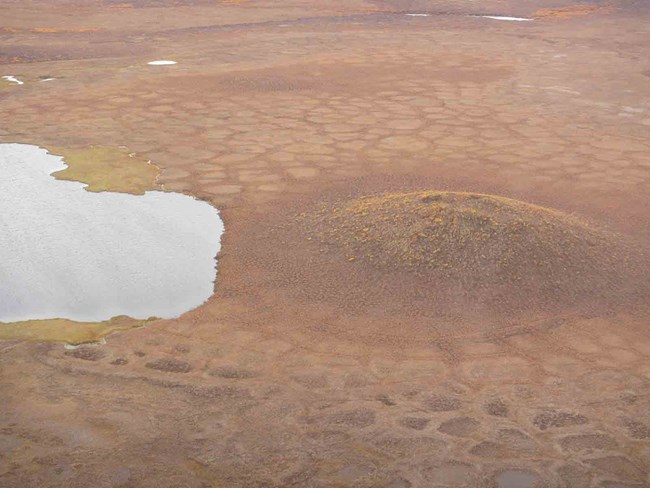
Permafrost underlies most of the Arctic Network and affects nearly everything in Arctic ecosystems, from soils and vegetation to water and wildlife. Permafrost is frozen ground that doesn’t thaw in the summer due to a cold climate. Permafrost perches water near the surface, making soils wet and runoff fast. The striking polygonal patterned ground so characteristic of the Arctic is due to permafrost. Ice can build up in the ground and then thaw, producing pits, ponds, lakes, and landslides. As our climate warms, permafrost is thawing. Thawing permafrost has many consequences, such as drainage of lakes, creation of new ponds, soil erosion, slumps, siltation of streams and lakes, release of greenhouse gases, and changes in soil wetness and nutrient supplies.
We monitor permafrost across the Arctic Network to document:
- Trends over time in ground temperatures at representative sites in the Arctic Network. This will indicate whether the permafrost is stable or likely to thaw.
- The area covered by slumps and landslides due to thaw of permafrost and changes over time.
- The growth rate of large slumps caused by thaw of permafrost and the rate of sediment loss from slumps.
-
Ice Wedges in Alaska's National Parks
Ice wedges can resemble a giant quilt when seen from the air and form only where permafrost is found. During very cold weather, solidly frozen ground can shrink and crack. When snow melts in spring, water runs into the cracks and freezes, which causes the cracks to grow. Most cracks are preserved beneath the ground surface. If the ground above ice wedges is disturbed by vehicle traffic or warmer conditions, however, the ground above the cracks melts and reveals the ice wedges.
- Duration:
- 1 minute, 11 seconds
-
Pingos in Alaska's Arctic
Pingos are hills that rise abruptly out of flat landscapes of the Alaskan arctic. When lakes dry up, the unfrozen ground that was once protected beneath the lake is exposed and freezes. The ice expands upward, and ping! The result is a pingo. Pingos provide important habitat for foxes and other arctic animals. As permafrost thaws, pingos collapse. NPS scientists are monitoring Alaska's permafrost by mapping landforms like pingos, wedges, and thaw slumps.
- Duration:
- 58.542 seconds
-
Arctic Lake Drainage
As permafrost thaws, lakes fill with water. If the water levels get too high, erosion channels can form and drain the lakes. In recent years, large lakes in Bering Land Bridge National Preserve have drained. This is of particular concern because these large lakes are important habitat for Yellow-billed Loons.
- Duration:
- 1 minute, 21 seconds
Learn more
Last updated: December 8, 2025

